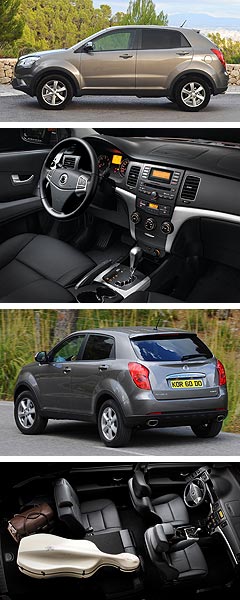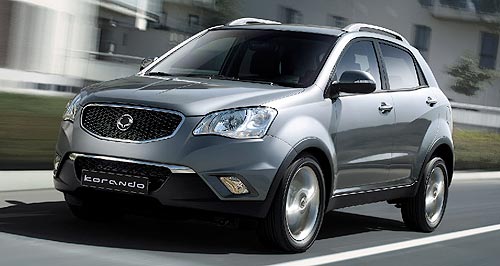Make / Model Search
Future models - SsangYong - KorandoSsangYong all set for Korando launchPrice point: SsangYong has indicated that the Korando will priced against similar SUVs including the Hyundai ix35, Kia Sportage, Nissan Dualis and Volkswagen Tiguan. Full details of SsangYong’s crucial Korando SUV emerge in UK as Aussie launch nears4 Nov 2010 By TERRY MARTIN SSANGYONG has unveiled full details of its crucial new Korando compact SUV in the UK, which will emulate Australia in reaching showrooms in January next year and provide the South Korean brand with a model that should significantly boost its sales volume. Now under the control of Indian auto giant Mahindra, SsangYong will commence right-hand drive production of the Korando in South Korea this month and has this week revealed that it will offer the vehicle in the UK with a high level of specification across two trim levels, two drivelines (4x2 and 4x4), two six-speed transmissions – including an Australian-developed six-speed automatic – and a single diesel engine. Australia was expected to also have a petrol engine available at launch, but SsangYong Motors Australia sales and marketing manager Steven Thomas has confirmed to GoAuto that the brand will stick with its all-diesel policy for the time being. He said the “jury is still out” on whether Australia will take the petrol engine, which will become available later in 2011, along with a still-to-be-specified “even more frugal diesel engine”.  From launch, the headline act will be a new Euro 5-compliant ‘e-XDi200’ 2.0-litre direct-injection common-rail four-cylinder diesel engine featuring Electric Variable Geometry Turbocharger technology (E-VGT) and producing 129kW of power at 4000rpm and 360Nm of torque from 2000-3000rpm. From launch, the headline act will be a new Euro 5-compliant ‘e-XDi200’ 2.0-litre direct-injection common-rail four-cylinder diesel engine featuring Electric Variable Geometry Turbocharger technology (E-VGT) and producing 129kW of power at 4000rpm and 360Nm of torque from 2000-3000rpm.Based on European standards, which should translate to Australia, the front-drive manual version of the Korando offers combined-cycle fuel economy of 6.0L/100km and CO2 emissions of 157g/km, with the 4x2 automatic variant coming in at 7.3L/100km and 194g/km. Slightly heavier AWD versions return 6.4L/100km (auto: 7.5) and 169g/km (auto: 199). Two-wheel-drive, manual-gearbox versions tip the scales with a 1591kg kerb weight (auto adds 20kg), while 4WD versions weigh in at 1672kg. In terms of acceleration, both front-drive and AWD variants can reach 100km/h from standstill in a claimed 10.0 seconds with the manual transmission, on their way to a top speed of 195km/h (auto: 186km/h). Automatic variants, which use a transmission developed by Albury-based Drivetrain Systems International and can be operated via steering-mounted shift controls, are slightly slower to 100km/h, reaching the benchmark in 10.8 seconds. The five-door, five-seat crossover has an all-steel monocoque construction and a fully independent suspension, with MacPherson struts up front and a multilink design at the rear. The steering is an electric (rather than conventional hydraulic) power-assisted rack-and-pinion system, offering 2.88 turns lock to lock and enabling a 10.9-metre turning circle. The brakes comprise 294mm x 26mm ventilated front discs and 262mm (2WD)/284mm (4WD) x 10mm solid rear discs, with supporting electronic systems including four-channel ABS, brake assist, hill-start assist, electronic stability control and ‘active rollover protection’. In the UK, six airbags (dual front, front side, and front and rear curtain airbags) are fitted standard across the Korando range, along with anti-whiplash front head restraints, front seatbelt pretensioners and load limiters, a ‘rear obstacle warning system’ with three-stage alarm, and an automatic emergency stop signal that warns following vehicles of emergency braking and ABS activation. While two-wheel drive sees 100 per cent of engine power delivered to the front wheels, the 4WD variants use an electronically controlled on-demand system that also runs as a front-driver in normal conditions but will feed power to the rear wheels when a loss of front-wheel traction is detected. The system also offers a manually selected ‘AWD Lock’ mode that can force the spread of power between the front and rear wheels at speeds below 40km/h. As is the norm in this class of vehicle, there is no low-range gearing, but SsangYong insists that off-road capability in the Korando has not been sidelined, pointing to its 180mm ground clearance, 22.8-degree approach angle, 28.2-degree departure angle, 18.5-degree ramp-over angle, a maximum climb angle of 48 per cent for AWD variants (2WD: 33 per cent) and a 300mm wading depth. The Korando rests on a 2650mm wheelbase and measures 4410mm in overall length, 1830mm in width (excluding door mirrors) and 1675mm in height. The front and rear track is 1573/1558mm respectively, while the front and rear overhang is 920/840mm. The fuel tank holds 57 litres and the maximum braked towing capacity is 2000kg. Inside, the tale of the tape shows front/rear headroom at 1010/990mm, legroom at 1035/940mm, shoulder room at 1450/1410mm and hip room at 1365/1340mm. Maximum cargo volume is 486 litres behind the 60/40 split-fold rear seats. According to SsangYong, the interior designers have sought to combine “the oriental ethos of moderation and elegance” and have achieved a cabin with “subtle design detailing to punctuate a spacious and practical interior”. Evidence of the latter includes drink holders front and rear and a host of other storage solutions, both in the passenger compartment and cargo area. Onboard security features include an engine immobiliser, alarm and automatic door locking at speeds above 30km/h, while convenience items stretch to folding exterior mirrors (with automatic puddle lights and indicators included) and an illuminated ignition key slot. Equipment listed for UK-spec cars include six-way driver’s seat power adjustment (plus lumbar support), leather or woven cloth upholstery, heated front and second-row seats, climate-control air-conditioning (for high-series models), tinted windows, roof rails, cruise control, a six-speaker CD/MP3 stereo (with USB memory slot, aux port and Bluetooth), steering-mounted audio controls, automatic and auto-levelling headlights, rain-sensing windscreen wipers, one-touch indicators, a sunroof, power windows (with anti-trap feature), remote central locking, a trip computer and two 12-volt power outlets. Wheel specifications comprise 16-inch alloys with 215/65-section tyres to 17-inch rims with 225/60 rubber, while 18-inch ‘hyper silver’ alloys with 225/55 tyres will also be available. The standard spare wheel in the UK is a ‘tyre mobility kit’, while a space-saver steel spare wheel and tyre is available as an option. Pricing details are yet to be announced in the UK, or Australia, but the company has promised it will be competitive against others in class including the Hyundai ix35, Kia Sportage, Nissan Dualis and Volkswagen Tiguan.  Read more9th of September 2010  SsangYong eyes expansion into passenger carsBorn-again SsangYong working on fresh models to follow Korando SUV launch13th of August 2010  SsangYong will go to IndiaIndia’s Mahindra named as preferred bidder for South Korea’s SsangYongAll future models Alfa Romeo Alfa Romeo Abarth Abarth Alpine Alpine Alpina Alpina Audi Audi Aston Martin Aston Martin BMW BMW Bentley Bentley Chery Chery Brabham Brabham Chrysler Chrysler Chevrolet Chevrolet Cupra Cupra Citroen Citroen DS DS Dodge Dodge Fiat Fiat Ferrari Ferrari Foton Foton Ford Ford Great Wall Great Wall FPV FPV Haval Haval GWM GWM Honda Honda Holden Holden Hummer Hummer HSV HSV Infiniti Infiniti Hyundai Hyundai Jaguar Jaguar Isuzu Isuzu Kia Kia Jeep Jeep Land Rover Land Rover Lamborghini Lamborghini Lexus Lexus LDV LDV Mahindra Mahindra Lotus Lotus Mazda Mazda Maserati Maserati Mercedes-AMG Mercedes-AMG McLaren McLaren MG MG Mercedes-Benz Mercedes-Benz Mitsubishi Mitsubishi Mini Mini Opel Opel Nissan Nissan Peugeot Peugeot Pagani Pagani Proton Proton Porsche Porsche Renault Renault Ram Ram Rover Rover Rolls-Royce Rolls-Royce Skoda Skoda Saab Saab SsangYong SsangYong Smart Smart Suzuki Suzuki Subaru Subaru Toyota Toyota Tesla Tesla Volvo VolvoKorando pricingMotor industry news |
Click to shareSsangYong modelsResearch SsangYong All future models Alfa Romeo Alfa Romeo Abarth Abarth Alpine Alpine Alpina Alpina Audi Audi Aston Martin Aston Martin BMW BMW Bentley Bentley Chery Chery Brabham Brabham Chrysler Chrysler Chevrolet Chevrolet Cupra Cupra Citroen Citroen DS DS Dodge Dodge Fiat Fiat Ferrari Ferrari Foton Foton Ford Ford Great Wall Great Wall FPV FPV Haval Haval GWM GWM Honda Honda Holden Holden Hummer Hummer HSV HSV Infiniti Infiniti Hyundai Hyundai Jaguar Jaguar Isuzu Isuzu Kia Kia Jeep Jeep Land Rover Land Rover Lamborghini Lamborghini Lexus Lexus LDV LDV Mahindra Mahindra Lotus Lotus Mazda Mazda Maserati Maserati Mercedes-AMG Mercedes-AMG McLaren McLaren MG MG Mercedes-Benz Mercedes-Benz Mitsubishi Mitsubishi Mini Mini Opel Opel Nissan Nissan Peugeot Peugeot Pagani Pagani Proton Proton Porsche Porsche Renault Renault Ram Ram Rover Rover Rolls-Royce Rolls-Royce Skoda Skoda Saab Saab SsangYong SsangYong Smart Smart Suzuki Suzuki Subaru Subaru Toyota Toyota Tesla Tesla Volvo VolvoKorando pricingMotor industry news |











Facebook Twitter Instagram